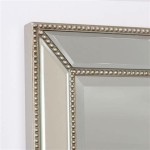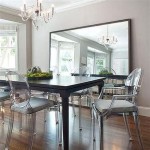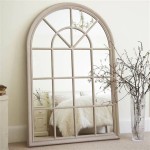Crown Molding Bathroom Mirror: Elevating Elegance and Functionality
The bathroom, often considered a utilitarian space, can be transformed into a haven of relaxation and style with careful attention to detail. Incorporating crown molding around a bathroom mirror is a design choice that elevates the room's aesthetic, adding a touch of sophistication and creating a focal point. This architectural detail, traditionally associated with grand living spaces, brings a sense of luxury and refinement to even the most modest bathroom.
Crown molding, generally installed where the wall meets the ceiling, provides a visual transition and enhanced architectural interest. When applied to a bathroom mirror, the effect is even more pronounced. It frames the reflection, drawing the eye and lending importance to the mirror itself. This seemingly small change can significantly impact the overall ambiance of the bathroom, turning a functional necessity into a decorative element.
The application of crown molding to a bathroom mirror can be achieved through various methods, each with its own set of considerations. These include selecting the appropriate type of molding, determining the optimal size and scale for the space, and executing the installation with precision and care. Furthermore, the choice of materials, finish, and style must be carefully considered to complement the existing bathroom decor and achieve the desired aesthetic outcome.
Selecting the Right Crown Molding for Your Bathroom Mirror
Choosing the appropriate crown molding for a bathroom mirror requires considering several factors, including the style of the bathroom, the size of the mirror, and the overall aesthetic desired. The material of the molding is also a crucial consideration, given the bathroom's humid environment.
Material Considerations: In bathrooms, moisture resistance is paramount. Traditional wood molding, while beautiful, is susceptible to warping, rotting, and mildew in humid conditions. Therefore, alternative materials like polyurethane, PVC, or medium-density fiberboard (MDF) treated with a moisture-resistant coating are often preferred. Polyurethane is lightweight, easy to install, and completely waterproof, making it an excellent choice for bathrooms. PVC molding is also highly durable and moisture-resistant, but it may have a less refined appearance than polyurethane. Moisture-resistant MDF is a budget-friendly option but requires careful sealing and painting to prevent water damage. Consider the ease of cutting and installing each material as well.
Style Compatibility: The style of the crown molding should complement the existing bathroom decor. For a traditional bathroom, ornate moldings with intricate details and classic profiles are suitable. In contrast, a modern or minimalist bathroom might benefit from simpler, cleaner lines. Consider the existing fixtures, cabinetry, and tile work when choosing the molding style. A mismatch in styles can detract from the overall aesthetic.
Size and Scale: The size of the crown molding should be proportional to the size of the mirror and the overall dimensions of the bathroom. A large, ornate molding might overwhelm a small mirror or a small bathroom. Conversely, a too-small molding might appear insignificant and get lost in the space. A good rule of thumb is to select a molding width that is roughly proportional to the height of the mirror. Experimenting with different sizes and profiles, even using painter’s tape to simulate the effect, can help determine the optimal size.
Pre-finished vs. Unfinished: Crown molding is available in both pre-finished and unfinished options. Pre-finished molding offers convenience, as it eliminates the need for painting or staining. Unfinished molding, on the other hand, allows for customization and the ability to perfectly match the existing paint colors in the bathroom. If choosing unfinished molding, ensure the appropriate primer and paint are used to protect the material from moisture.
Installation Techniques for Crown Molding Around a Bathroom Mirror
Proper installation is critical to achieving a professional and aesthetically pleasing result. The process involves precise measuring, cutting, and securing the molding to the mirror or the wall surrounding it. Safety precautions and patience are essential for a successful installation.
Preparation: Before starting the installation, gather all the necessary tools and materials. This includes the crown molding of choice, a miter saw, a measuring tape, a level, a pencil, construction adhesive, finishing nails, a nail gun (optional), sandpaper, paint or stain (if using unfinished molding), paintbrushes, and safety glasses. Carefully measure the perimeter of the mirror to determine the required length of molding. Add extra material for mitering the corners.
Cutting the Molding: Accurate cuts are essential for seamless corners. Use a miter saw to cut the molding at a 45-degree angle for each corner. Ensure the cuts are precise and clean. For inside corners, the molding pieces should be cut to meet flush against each other. For outside corners, the molding pieces should be cut to overlap slightly. Practice cutting on scrap pieces of molding before cutting the final pieces.
Adhering the Molding: Apply construction adhesive to the back of the molding. Position the molding around the mirror, ensuring it is level and properly aligned. Press the molding firmly against the mirror or the wall to allow the adhesive to adhere. Use finishing nails to secure the molding in place, if necessary. A nail gun can speed up this process. However, use caution when using a nail gun near glass to avoid shattering the mirror. Alternatively, strong adhesive tape specifically designed for mirrors may provide an adequate bond.
Finishing Touches: Once the adhesive has dried, inspect the molding for any gaps or imperfections. Fill any gaps with caulk and sand smooth. If using unfinished molding, apply primer and paint or stain to match the existing decor. Allow the paint or stain to dry completely before using the bathroom. Clean any excess adhesive or caulk from the mirror and surrounding surfaces.
Alternative Installation Methods: Depending on the size and weight of the molding, and the surface to which it is being attached, consider alternative installation methods. For lightweight molding, strong double-sided adhesive tape designed for mirrors can provide a secure and clean installation. When attaching molding directly to the wall surrounding the mirror, ensure the wall is properly prepared and primed. Utilize wall anchors if necessary, particularly when installing heavier molding.
Enhancing Bathroom Aesthetics with Crown Molding Mirror Designs
The application of crown molding to a bathroom mirror opens a range of design possibilities, allowing homeowners to customize the look and feel of their bathroom. From subtle enhancements to bold statements, crown molding can transform a plain mirror into a stunning focal point.
Framing Styles: The most common approach is to create a traditional frame around the mirror, with the crown molding serving as the border. However, variations on this theme can create unique and eye-catching designs. For example, a "shadow box" effect can be achieved by installing the molding with a slight gap between the mirror and the wall, creating a sense of depth. Another option is to use multiple layers of molding, with each layer adding dimension and visual interest.
Color and Finish: The color and finish of the crown molding can significantly impact the overall aesthetic. White or off-white molding is a classic choice that complements a wide range of bathroom styles. However, bold colors can be used to create a striking contrast or to tie in with other decorative elements in the room. Metallic finishes, such as gold or silver, can add a touch of glamour and sophistication. Consider matching the finish of the molding to the existing hardware in the bathroom, such as the faucets and light fixtures.
Lighting Integration: Crown molding can be used to conceal and integrate lighting elements around the mirror. LED strip lights can be installed behind the molding to create a soft, ambient glow. This provides functional lighting for tasks like applying makeup or shaving, while also enhancing the overall ambiance of the bathroom. Consider using dimmable lights to adjust the brightness as needed.
Mirror Shape and Size: The shape and size of the mirror should be considered when designing the crown molding frame. A rectangular mirror lends itself well to a traditional frame, while a round or oval mirror might benefit from a more creative approach. In some cases, the crown molding can be used to create a custom shape around the mirror, adding a unique and personalized touch. For example, elongated mirrors can be framed to give the illusion of higher ceilings, maximizing the sense of space.
Incorporating crown molding into a bathroom mirror design is a versatile way to enhance the space's style and functionality. By carefully considering the material, style, installation techniques, and design possibilities, homeowners can create a bathroom that is both beautiful and practical.

Bathroom Mirror Framed With Crown Molding Large Mirrors Frame Makeover

Bathroom Mirror Framed With Crown Molding Frame Mirrors Diy Large

Crafty Again
How To Upgrade Your Builder Grade Mirror Frame It

Mirror Molding Framing A With Crown Mirrormate

Love This Mirror Idea Budget Bathroom Remodel Bathrooms

Mirror Molding The Easy Upgrade To Boring Bathrooms Mirrorchic
How To Upgrade Your Builder Grade Mirror Frame It

How To Frame A Bathroom Mirror Nest For Less

Crafty Again








